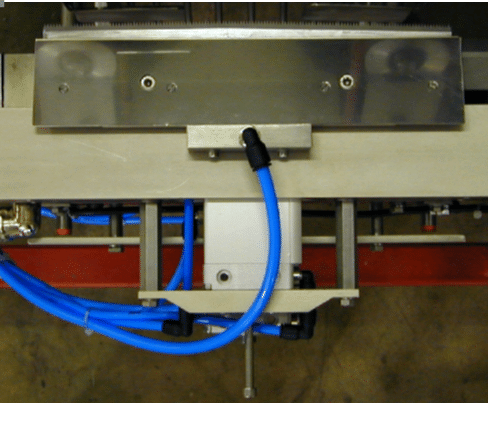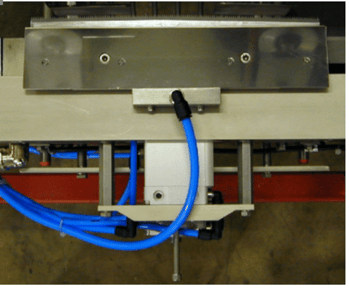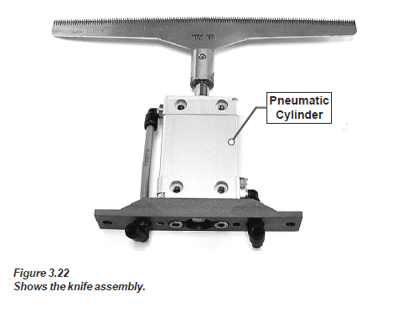The Secret Ingredient for Long Term VFFS Machine Reliability
For most of us, when we decide to make a purchase, the interaction with the team that designed and produced it is short-lived. When we go to buy...
7 min read
 Emily Brogan
:
Tue, Dec 12, 2023
Emily Brogan
:
Tue, Dec 12, 2023

 Recently, I had the opportunity to sit with Allen Overmyer, senior technical advisor and one of Rovema's "big guns" for an interview to discuss the process that he has taken over the last 30 years for troubleshooting issues with a VFFS machine cutting knife.
Recently, I had the opportunity to sit with Allen Overmyer, senior technical advisor and one of Rovema's "big guns" for an interview to discuss the process that he has taken over the last 30 years for troubleshooting issues with a VFFS machine cutting knife.
To kick off the conversation, I asked him a few questions about his career path and how he came to be the VFFS troubleshooting master that he is today.
I understand that some of the readers who come to this post might not find his career history of working on 3000 foot long limestone kilns as important as the knife troubleshooting content if you have a proverbial fire to put out, so to jump to that you can click here.
Emily Brogan
Before we dive into the technical details of our topic today, tell me a bit about your background with Rovema. How long have you been with the company?Allen Overmyer
Back in July of 1990, I was hired on to be a service technician. I started back in the shop, you know, to learn the machines. A little bit of everything, from electrical to mechanical. I come from a background up in Ohio from a limestone quarry. I was a class three maintenance tech.They'd take stone out of the ground, and put it through these big long kilns, about 3000 feet long, 10 football fields. They put fire to it and it turns into limestone. So a lot of big equipment.
So, I had a lot of hands on learning with bearings and belts and how to measure with micrometers and Vernier calipers. That was my teen years. I worked there for about seven or eight years. Then I moved to Florida and went into the optical industry where I’d go in to eye doctors places and show them how to grind the prescription into the lenses. I did that for about four years.
Anyways, then Don Lawrence, he moved up here and he called me and says, “Hey, they have an opening where I'm at, at a company called Rovema. And so I went to work there.
Allen spent these ~25 years at Rovema Packaging Machines, LP, a separate sales and service agency for Rovema machines that has since closed. When this facility closed, Rovema North America was able to purchase their records and assets and offered many of their seasoned employees new positions. Completed in late 2015, the transition provided RNA the opportunity to gain many of our most valuable assets: decades of Rovema machine knowledge in the personnel who then came to work with us. Allen Overmyer and Don Lawrence, who he mentions, have both been working with Rovema equipment for over 30 years.
Allen Overmyer
Don started in 89. And I started in 90. I started as a service tech and traveled all over installing and troubleshooting machines for 12 years. And then I came off the road into the demo room and helped set up machines and demo the machines. Then I moved into the service department as a service manager for 10 years or so. When Don and I moved to Rovema North America, I started out as the service manager and then I moved to the spare parts manager. Now, I'm the senior technical advisor.Emily Brogan
That's such a cool career journey. You're certainly a familiar face from many of the the resources that we have on the website and the videos that we have on the Rovema North America YouTube channel.So, outside of contributing to those resources, what does your day typically look like?
Allen Overmyer
Well, of course my day varies, but since we’ve added some more hands to the Life Cycle Services team, I have been spending time helping them learn about all of the machinery and their parts and available upgrades. I know a lot about the older equipment, from my time as a service technician and service manager. So, when somebody calls and wants to do something like a film carriage extension to put a second roll on an older machine, I know where to go and I make sure to walk the newer people through how I walk through that process.Not just fishing for them but making sure they know how to fish.
So I spend time teaching and supporting other departments, where needed, and then of course I spend a lot of time with customers on the phone, troubleshooting and helping them improve the efficiency of their packaging lines.
If a customer calls and has a fault on their machine, I can quickly tell them what the fault is and how to clear it through our fault message database. I've been managing a running excel spreadsheet for all the faults that all machines have, from the machines that are 50+ years old to the ones we just launched in the last couple years.
Emily Brogan
So, when you have an issue that you are walking a customer through, do you have a specific strategy that you try to use when you walk them through like, do you start at the front of the machine? Or do you even just start with like, the simplest task like turning it off and turning it back on again?Allen Overmyer
Well, first of all, I need to know what I'm looking at. Before we even go any further, I need to find out what machine it is so, I'll need either the model or serial number. Then usually, I'll go to their spare parts book, or I'll go through an operator's book, or I go to the electrical book that was originally built with it.Emily Brogan
So, how do you instruct the person on the other end of the line with troubleshooting those components?Allen Overmyer
Well, let's let's just do a common one on the machine. Okay, let's say a customer calls me and says, “Al, my knife on my VFFS machine isn’t working. I can’t separate my bags.” So, first thing is, again, pull all of my resources on their specific bagger and then start working through this process.So first we’ll start mechanically, then we’ll go pneumatically, then if we don't find the issue, we’ll go electrically.

The cutting knife assembly on a vertical bagger cuts the bags as they travel from the film tube and are filled with product. The knife is housed between the upper and lower sections of the front jaw assembly. When the seal jaws close to seal the package, the knife is extended and cuts the film. The extension and retraction movements are powered by a pneumatic cylinder with the timing of the movements being controlled by settings on your HMI.
The following is Allen Overmyer's 3 stage process for troubleshooting this cycle.
First, you look at the simple things. Maybe the knife is jammed up with product if they're bagging something with sugar in it. Chocolate, and things like that. Over time, the seal jaw motion can push that melted and burned product back into the knife shaft and gum everything up.
So, you need to see mechanically why the knife isn't firing- if the cutting knife is gummed up then you have a pretty simple resolution to the issue. You will just need to take the jaw assembly apart and clear out the obstructing product.
Elefant Sugar Dissolving Oil does a great job of breaking the sugar down with the cutting knife assembly.
The next step is to check the pneumatics of the cutting knife- You will want to switch the hoses.
There are two hoses on the air cylinder, one that pushes air back (and the knife back) and one that pushes the air (and knife) forward. So you if just switch those two hoses you can see if maybe your air cylinder is bad and is leaking.
So if it does extend out, and it's nice and not clogged up, that tells me that we need to go down to look at the solenoid.
The solenoid is where the electrical output shifts a spool to change the air direction to extend the knife out or extend the knife in.
There's a little manual button on this solenoid that you can push on and it should make the knife go in and out. If you do that and the customer says, “Nope, it won't shift back and forth.”
Then it’s likely one of these issues:
- The solenoid is broken
- The O ring in the solenoid has gone bad
So you likely need a new solenoid.But, let's say it does work and the manual option works and it goes in and out?
So in these little solenoids, there’s a small magnetic coil. Have you ever built a magnet with a nail wrapped around it picks up stuff? It’s the same concept. What happens is every time you put power to the solenoid, the magnetic force pulls that spool in and out to switch the knife direction. So if that magnet is bad, then we know that electrically the solenoid is bad.
Emily Brogan
I know that keeping the vertical bagger knife clean and using technologies like Sense and Seal ®️ on these newer machines can help prevent getting in product in the seal area in the first place and causing those mechanical issues for the knife of your packaging machine. But as far as bad cylinders or bad solenoids, is there anything in particular that causes this issue or ways to prevent it?Allen Overmyer
Unfortunately, no. I give customers the adage of the alternator on their car. You can't tell me when that alternator or the starter is going to go back on your car. So it's the same thing on the air cylinder or solenoid.Emily Brogan
In that case, how fast can Rovema typically get a solenoid or cylinder out to somebody?Allen Overmyer
Pretty fast, we keep them as a stock item here at RNA. We can always overnight ship stuff like that if machines are down but I will usually put those electrical parts on a recommended spare parts list to keep on hand. It's not like it's a consumable like the knife itself but I would keep it on my shelf.Emily Brogan
So that's your troubleshooting strategy, is to take it in that order.Allen Overmyer
Sure thing. Sometimes the simple solutions are all that most customers need. Having the ability to troubleshoot over the phone, without a technical service expert going there is a free service.These cutting knives are a standard part. Everyone's got a knife. Everybody's got an air cylinder. Everybody's got a solenoid. So those are common things, and that’s really my universal process for troubleshooting the root cause of the issue with the knife on your bagger.
Allen and I spent a few more minutes talking about a separate issue that I had discussed with someone in our chat feature on the website about a problem with their auger filler.
Unsurprisingly, the conversation ended with him receiving a phone call from a customer, which likely went right along the same process that he walked me through.
Like Allen, the rest of the Rovema Life Cycle Services team is passionate about providing the most efficient and effective VFFS service and support solutions.
The deep knowledge of our team members like Allen is something I’d like to continue to tap in to so that we can continue to grow the VFFS service resources on our website. If you have a troubleshooting topic that you’d like for us to dig in to next, let us know in the chat box to the right. 👉👉
If you’ve walked through this process and are still having issues, let me know in the chat as well and I can connect you with Allen or one of the other talented Rovema VFFS service experts. If you'd like to be notified when we publish new resources like this one, you can subscribe to our blog at the top right of the page.

For most of us, when we decide to make a purchase, the interaction with the team that designed and produced it is short-lived. When we go to buy...

What happens when you notice that your pillow bag or stand-up pouch is not sealing correctly? Obviously, you want to efficiently troubleshoot and fix...

1 min read
Driving out inefficiencies We know that manufacturers see spare parts as something they have to deal with to keep their machine running. Our job is...